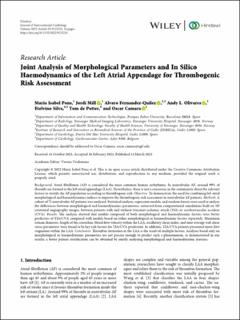| dc.contributor.author | Pons, Maria Isabel | |
| dc.contributor.author | Mill, Jordi | |
| dc.contributor.author | Fernandez Quilez, Alvaro | |
| dc.contributor.author | Olivares, Andy L. | |
| dc.contributor.author | Silva, Etelvino | |
| dc.contributor.author | De Potter, Tom | |
| dc.contributor.author | Camara, Oscar | |
| dc.date.accessioned | 2023-01-23T12:56:01Z | |
| dc.date.available | 2023-01-23T12:56:01Z | |
| dc.date.created | 2022-04-25T10:53:44Z | |
| dc.date.issued | 2022 | |
| dc.identifier.citation | Pons, M. I., Mill, J., Fernandez-Quilez, A., Olivares, A. L., Silva, E., de Potter, T., & Camara, O. (2022). Joint Analysis of Morphological Parameters and In Silico Haemodynamics of the Left Atrial Appendage for Thrombogenic Risk Assessment. Journal of interventional cardiology, 2022. | en_US |
| dc.identifier.issn | 0896-4327 | |
| dc.identifier.uri | https://hdl.handle.net/11250/3045353 | |
| dc.description.abstract | Background. Atrial fibrillation (AF) is considered the most common human arrhythmia. In nonvalvular AF, around 99% of thrombi are formed in the left atrial appendage (LAA). Nevertheless, there is not a consensus in the community about the relevant factors to stratify the AF population according to thrombogenic risk. Objective. To demonstrate the need for combining left atrial morphological and haemodynamics indices to improve the thrombogenic risk assessment in nonvalvular AF patients. Methods. A cohort of 71 nonvalvular AF patients was analysed. Statistical analysis, regression models, and random forests were used to analyse the differences between morphological and haemodynamics parameters, extracted from computational simulations built on 3D rotational angiography images, between patients with and without transient ischemic attack (TIA) or cerebrovascular accident (CVA). Results. The analysis showed that models composed of both morphological and haemodynamic factors were better predictors of TIA/CVA compared with models based on either morphological or haemodynamic factors separately. Maximum ostium diameter, length of the centreline, blood flow velocity within the LAA, oscillatory shear index, and time average wall shear stress parameters were found to be key risk factors for TIA/CVA prediction. In addition, TIA/CVA patients presented more flow stagnation within the LAA. Conclusion. Thrombus formation in the LAA is the result of multiple factors. Analyses based only on morphological or haemodynamic parameters are not precise enough to predict such a phenomenon, as demonstrated in our results; a better patient stratification can be obtained by jointly analysing morphological and haemodynamic features. | en_US |
| dc.language.iso | eng | en_US |
| dc.publisher | Hindawi | en_US |
| dc.rights | Navngivelse 4.0 Internasjonal | * |
| dc.rights.uri | http://creativecommons.org/licenses/by/4.0/deed.no | * |
| dc.title | Joint Analysis of Morphological Parameters and In Silico Haemodynamics of the Left Atrial Appendage for Thrombogenic Risk Assessment | en_US |
| dc.title.alternative | Joint Analysis of Morphological Parameters and In Silico Haemodynamics of the Left Atrial Appendage for Thrombogenic Risk Assessment | en_US |
| dc.type | Peer reviewed | en_US |
| dc.type | Journal article | en_US |
| dc.description.version | publishedVersion | en_US |
| dc.rights.holder | The author | en_US |
| dc.subject.nsi | VDP::Medisinske Fag: 700 | en_US |
| dc.source.volume | 2022 | en_US |
| dc.source.journal | Journal of interventional cardiology | en_US |
| dc.identifier.doi | 10.1155/2022/9125224 | |
| dc.identifier.cristin | 2018836 | |
| cristin.ispublished | true | |
| cristin.fulltext | original | |
| cristin.qualitycode | 1 | |

